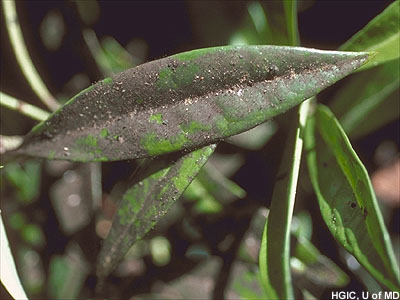Cottony Camellia Scale
By Ray Novitske, Fairfax Master Gardener
When we see the term cottony camellia scale, we concentrate on the first two pleasant words “cottony” and “camellia.” They evoke ideas of something comforting and beautiful. But this scale insect that attacks our ornamentals at this time of year is anything but that.

Cottony Camellia scale egg sacs on underside of leaf
First, this is not a scale that attacks only camellias. I have seen it on hollies more than any other plant, but it also likes English ivy, yews, euonymus, hydrangea, maples and rhododendrons, in addition to the plant it is named for. In low numbers, the scale does little damage to the plants, But in higher infestations, the plant can end up weakened, its growth stunted, and more susceptible to disease. Because they are so small with adults being less than 1/8 inch long, they can build up large populations before they are noticed.

Magnified view of scale on leaf vein
The damage to plants may go unnoticed if the cottony camellia scales are low in numbers. One sign of the damage might include foliage that turns pale green or yellow. Some leaves may develop black spots where sooty mold begins to show up from the scale’s droppings.
The scales develop through the summer and overwinter on twigs and branches. They emerge in spring with adult females laying their eggs. The good news is that there is only one generation per year.
There can be many generations in low numbers on ornamentals for several years with no decline in the plants being noticed. Look on the underside of plants for the telltale cottony egg sacs, or for black sooty mold developing. Populations can remain in check by various parasitoids for years, but these have not been shown effective as a treatment.

Sooty mold on non-infected leaves
Use insecticidal soap early in the life cycle when the scales are in the crawler stage, usually in the beginning of June. Chemical insecticides like Imidacloprid (which is a neonicotinoid), Permethrin and Carbaryl, as well as less harsh Neem Oil and Spinosin can be used. Insecticides will have little effect once reaching the adult stage, and there are no consistently effective biological controls available.
It is important to remember that cottony camellia scale can be tolerated with no noticeable damage to the plant. It is when their populations become large and the plant strength is reduced that they need control.
References
• Home Grounds & Animals, Table 4.5, Virginia Cooperative Extension
• Scale Insects, Eric Day, Virginia Cooperative Extension
• Cottony Camellia Scale — Shrubs, University of Maryland Extension
• Camellia Diseases & Insect Pests, Clemson Cooperative Extension, Home & Garden Information Center,
Clemson University
• Camellia — Cottony camellia scale, Pacific Northwest Insect Management Handbook